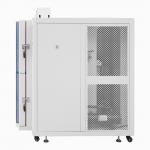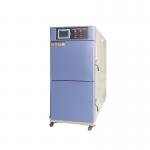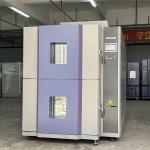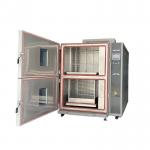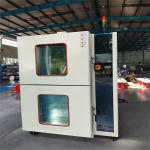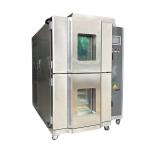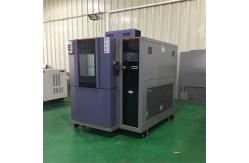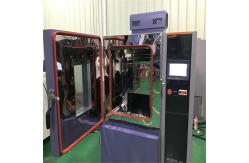In the highly demanding and safety-critical aerospace industry, the
need for precise and reliable testing equipment is non-negotiable.
The Customization Well-Improved Rapid Temperature Change Test
Chamber Environmental Chamber emerges as a bespoke solution,
meticulously designed to meet the unique and stringent requirements
of aerospace applications. This advanced test chamber, specifically customized for the
aerospace sector, is engineered to subject aerospace components,
materials, and systems to rapid and extreme temperature
fluctuations. Its primary purpose is to replicate the harsh thermal
conditions that aerospace products encounter during their
lifecycle, including flight at high altitudes, re-entry into the
atmosphere, and exposure to varying environmental conditions on the
ground and in space. By accurately simulating these conditions,
aerospace manufacturers and research institutions can identify
potential weaknesses, optimize product designs, and ensure
compliance with the most exacting industry standards and
regulations. - Ultra-Robust and Space-Age Design
- The chamber is constructed with a heavy-duty framework, fabricated
from high-strength aerospace-grade alloys, to withstand the extreme
forces and stresses associated with rapid temperature cycling. The
exterior is designed to be not only durable but also resistant to
the corrosive effects of the elements and the unique environmental
factors present in aerospace testing. The interior is lined with a
non-reactive and ultra-smooth surface, such as a specialized
ceramic or advanced composite material, to prevent any interaction
between the chamber and the highly sensitive aerospace specimens.
The door is engineered for an airtight and hermetic seal, featuring
a redundant locking mechanism and a high-performance gasket. It
also includes a large, optically clear viewing window, made of a
toughened and scratch-resistant material with anti-reflective
coatings, enabling detailed visual monitoring of the testing
process without compromising the internal temperature integrity.
- Precision Temperature Control Systems for Aerospace Extremes
- High-Temperature Zone: The high-temperature system is capable of
reaching temperatures up to +300°C or even higher, with an accuracy
of ±0.2°C. It utilizes state-of-the-art heating elements and a
highly sophisticated temperature control loop, along with a network
of strategically placed temperature sensors. This ensures rapid and
uniform heating of the samples, essential for accurately
replicating the intense heat experienced during re-entry or in
high-temperature engine environments. The system also incorporates
multiple layers of safety features, including redundant temperature
cutoffs and emergency cooling systems, to prevent overheating and
protect both the samples and the chamber components.
- Low-Temperature Zone: The low-temperature system can achieve
extremely cold temperatures, typically down to -100°C or lower,
with an accuracy of ±0.2°C. It employs advanced cryogenic
refrigeration technologies and a precision temperature control
mechanism. The chamber is equipped with a highly efficient
circulation system that ensures even cold air distribution,
mimicking the frigid conditions of high-altitude flight or space.
Similar to the high-temperature system, it has comprehensive safety
features to avoid overcooling and safeguard the integrity of the
testing environment.
- Temperature Transition: The hallmark of this chamber is its ability
to transition between high and low temperatures at an unprecedented
rate. The temperature change rate can be as fast as 30°C to 40°C
per minute, allowing for a highly realistic simulation of the
extreme thermal cycling that aerospace products endure. The control
panel, which is designed with aerospace-grade electronics and
software, enables users to program and adjust complex temperature
profiles, including the duration of each temperature stage, the
number of cycles, and the rate of temperature change. It also
offers advanced features such as pre-programmed aerospace standard
test sequences and the ability to interface with flight data
recorders and simulation software.
- Advanced Instrumentation and Data Acquisition for Aerospace
Insights
- The chamber is outfitted with a comprehensive suite of sensors.
Ultra-precise temperature sensors are distributed throughout the
chamber, with a density and accuracy that far exceed standard
requirements, ensuring that the samples experience the desired
temperature conditions with the utmost uniformity. These sensors
are connected to a cutting-edge data acquisition system that
records and stores all the temperature data. The data can be
accessed and analyzed in real-time or retrieved later for in-depth
studies. The data acquisition system is highly flexible and can be
integrated with aerospace-specific software and databases,
facilitating seamless data transfer and analysis. It can also be
configured to send notifications and reports automatically, saving
time and effort for the users. Additionally, the control panel
includes built-in alarms and safety features that alert users in
case of any abnormal temperature conditions, power failures, or
equipment malfunctions. It also has the capability to interface
with ground control systems and remote monitoring stations,
allowing for continuous oversight and intervention if necessary.
- Volume and Dimensions: The chamber is available in various sizes to accommodate
different aerospace component and system sizes. The volume can
range from a few liters for testing small, critical electronic
components to several cubic meters for larger structural assemblies
or full-scale mock-ups. The external dimensions are configured to
fit within aerospace testing facilities, taking into account
factors such as access, ventilation, and clearance for associated
equipment. The interior dimensions are optimized for proper air
circulation and temperature distribution, with a design that
minimizes thermal gradients and dead zones.
- Temperature Uniformity: The temperature uniformity within the chamber is maintained
within ±0.3°C during both high and low-temperature conditions. This
ensures that all parts of the tested aerospace samples experience a
nearly identical thermal environment, which is crucial for
obtaining accurate and reliable test results.
- Temperature Stability: Both the high and low-temperature systems offer exceptional
temperature stability, with minimal fluctuations over time. This
allows for consistent and repeatable testing, enabling aerospace
manufacturers to compare results accurately and make informed
decisions about product improvements.
- Temperature Change Rate: The chamber can achieve a rapid temperature change rate,
typically ranging from 30°C to 40°C per minute, depending on the
specific settings and the thermal load of the samples. This fast
transition capability is essential for simulating the real-world
scenarios that aerospace products face, such as the rapid
temperature changes during a space mission or a high-speed flight.
- Accurate Simulation of Aerospace Thermal Environments
- The primary function of this chamber is to provide a highly
accurate and realistic simulation of the extreme thermal conditions
that aerospace products encounter. By precisely controlling the
temperature transitions, it allows users to evaluate how components
and systems will behave in various thermal stress situations. For
example, it can test the integrity of heat shields during re-entry,
the performance of avionics in high-altitude cold and low-pressure
environments, and the durability of engine components under extreme
heat and vibration.
|
